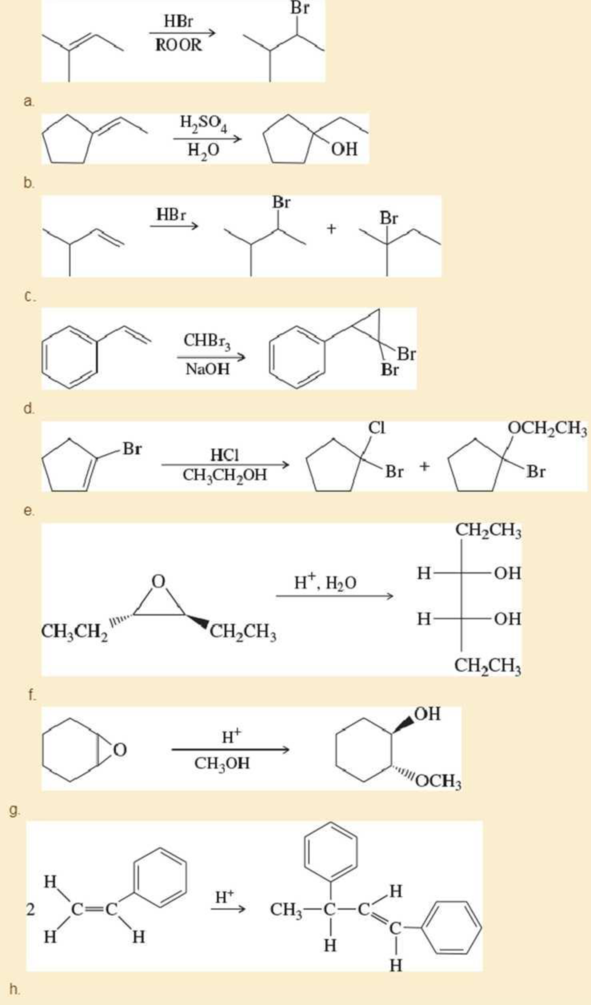
Organic Chemistry (9th Edition)
9th Edition
ISBN: 9780321971371
Author: Leroy G. Wade, Jan W. Simek
Publisher: PEARSON
expand_more
expand_more
format_list_bulleted
Concept explainers
Textbook Question
Chapter 8, Problem 8.56SP
Propose mechanisms consistent with the following reactions.

Expert Solution & Answer
Want to see the full answer?
Check out a sample textbook solution
Students have asked these similar questions
C
app.aktiv.com
Draw the product of the following reaction sequence. Ignore
any inorganic byproducts formed.
H
O
1. (CH3CH2)2CuLi, THF
2. CH3Br
Drawing
Draw the product of the following reaction sequence. Ignore
any inorganic byproducts formed.
H
O
1. (CH3CH2)2CuLi, THF
2. CHзBr
Drawing
Seee the attached ima
Chapter 8 Solutions
Organic Chemistry (9th Edition)
Ch. 8.3A - Predict the major products of the following...Ch. 8.3A - a. When 1 mole of buta-1,3-diene reacts with 1...Ch. 8.3B - Predict the major products of the following...Ch. 8.3B - Show how you would accomplish the following...Ch. 8.4B - Propose a mechanism to show how...Ch. 8.4B - Predict the products of the following hydration...Ch. 8.6 - a. Propose a mochansm fortho following reaction....Ch. 8.6 - Prob. 8.8PCh. 8.6 - Prob. 8.9PCh. 8.7A - Prob. 8.10P
Ch. 8.7A - Prob. 8.11PCh. 8.7C - Prob. 8.12PCh. 8.7C - Prob. 8.13PCh. 8.7C - a. When (Z)-3-methylhex-3-ene undergoes...Ch. 8.7C - Prob. 8.15PCh. 8.7C - Prob. 8.16PCh. 8.8B - Prob. 8.17PCh. 8.8B - Prob. 8.18PCh. 8.9 - Prob. 8.19PCh. 8.9 - Prob. 8.20PCh. 8.9 - Prob. 8.21PCh. 8.9 - Prob. 8.22PCh. 8.10 - Prob. 8.23PCh. 8.10 - Prob. 8.24PCh. 8.10 - Prob. 8.25PCh. 8.11A - Prob. 8.26PCh. 8.11B - Prob. 8.27PCh. 8.11B - Prob. 8.28PCh. 8.12 - Prob. 8.29PCh. 8.13 - a. Propose a mechanism for the conversion of...Ch. 8.13 - Magnesium monoperoxyphthalate (MMPP) epoxidizes...Ch. 8.13 - Predict the major products of the following...Ch. 8.13 - When 1,2-epoxycyclohexane (cyclohexene oxide) is...Ch. 8.14C - Predict the major products of the following...Ch. 8.14C - Prob. 8.35PCh. 8.15B - Prob. 8.36PCh. 8.15C - Predict the major products of the following...Ch. 8.16A - Prob. 8.38PCh. 8.16A - Prob. 8.39PCh. 8.16B - Prob. 8.40PCh. 8.16B - Prob. 8.41PCh. 8.16C - Prob. 8.42PCh. 8.17B - Prob. 8.43PCh. 8.17B - Prob. 8.44PCh. 8.17B - Show how you would synthesize each compound,...Ch. 8 - Prob. 8.46SPCh. 8 - Prob. 8.47SPCh. 8 - Give the products expected when the following...Ch. 8 - Show how you would make the following compounds...Ch. 8 - Using 1,2-dimethylcyclohexene as your starting...Ch. 8 - Show how you would synthesize each compound using...Ch. 8 - Prob. 8.52SPCh. 8 - Show how you might use olefin metathesis to...Ch. 8 - Prob. 8.54SPCh. 8 - Prob. 8.55SPCh. 8 - Propose mechanisms consistent with the following...Ch. 8 - Prob. 8.57SPCh. 8 - Prob. 8.58SPCh. 8 - Draw a reaction-energy diagram for the propagation...Ch. 8 - Prob. 8.60SPCh. 8 - Prob. 8.61SPCh. 8 - Prob. 8.62SPCh. 8 - Prob. 8.63SPCh. 8 - Prob. 8.64SPCh. 8 - Prob. 8.65SPCh. 8 - Prob. 8.66SPCh. 8 - Prob. 8.67SPCh. 8 - Prob. 8.68SPCh. 8 - Prob. 8.69SPCh. 8 - Prob. 8.70SPCh. 8 - Prob. 8.71SPCh. 8 - Prob. 8.72SPCh. 8 - Prob. 8.73SPCh. 8 - Prob. 8.74SPCh. 8 - Prob. 8.75SPCh. 8 - Prob. 8.76SPCh. 8 - Prob. 8.77SPCh. 8 - Prob. 8.78SPCh. 8 - Prob. 8.79SP
Additional Science Textbook Solutions
Find more solutions based on key concepts
The validity of a scientific law.
Physical Universe
Describe the role and impact of microbes on the earth.
Microbiology Fundamentals: A Clinical Approach
Why is it necessary to be in a pressurized cabin when flying at 30,000 feet?
Anatomy & Physiology (6th Edition)
Separate the list P,F,V,,T,a,m,L,t, and V into intensive properties, extensive properties, and nonproperties.
Fundamentals Of Thermodynamics
Knowledge Booster
Learn more about
Need a deep-dive on the concept behind this application? Look no further. Learn more about this topic, chemistry and related others by exploring similar questions and additional content below.Similar questions
- Look at the image attached pleaarrow_forwardComplete the mechanismarrow_forwardV Biological Macromolecules Drawing the Haworth projection of an aldose from its Fischer projection Draw a Haworth projection of a common cyclic form of this monosaccharide: H C=O HO H HO H H OH CH₂OH Explanation Check Click and drag to start drawing a structure. Xarrow_forward
- Complete the mechanismarrow_forwardComplete the mechanismarrow_forward8 00 6 = 10 10 Decide whether each of the molecules in the table below is stable, in the exact form in which it is drawn, at pH = 11. If you decide at least one molecule is not stable, then redraw one of the unstable molecules in its stable form below the table. (If more than unstable, you can pick any of them to redraw.) Check OH stable HO stable Ounstable unstable O OH stable unstable OH 80 F6 F5 stable Ounstable X Save For Later Sub 2025 McGraw Hill LLC. All Rights Reserved. Terms of Use | Privacy C ཀྭ་ A F7 매 F8 F9 4 F10arrow_forward
arrow_back_ios
SEE MORE QUESTIONS
arrow_forward_ios
Recommended textbooks for you

Characteristic Reactions of Benzene and Phenols; Author: Linda Hanson;https://www.youtube.com/watch?v=tjEqEjDd87E;License: Standard YouTube License, CC-BY
An Overview of Aldehydes and Ketones: Crash Course Organic Chemistry #27; Author: Crash Course;https://www.youtube.com/watch?v=-fBPX-4kFlw;License: Standard Youtube License